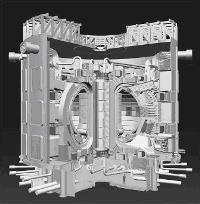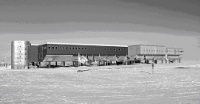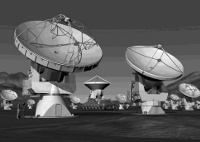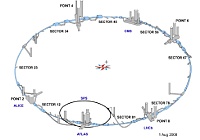 |
 |
|||||||||||||
|
|||||||||||||
|
|||||||||||||
|
The nature of modern scientific research has been changing due to the increased reliance on large-scale scientific facilities for forefront research. The programmes at our DOE National Laboratories have become focused more and more around large facilities and the programme of Major Research Equipment and Facilities Construction (MREFC) has emerged as a very important part of the NSF research portfolio. The NSF programme began with physics and astronomy initiatives, but has expanded into other disciplines. Will this movement toward larger and larger science continue into the future, and if so, how should we adapt our science policies? The more ambitious we become about our research goals, the more sophisticated and larger-scale instruments will be motivated and proposed and the research efforts themselves will involve larger teams of scientists. How should we respond to these trends in support of science? And, how can we ensure that we make the best investments, from the standpoints of moving science forward, educating our scientific workforce, and more generally, in terms of the goals of the American Competitiveness Initiative or the America Competes Act? The investments we can make in large-scale scientific facilities are resource limited and therefore they must be determined by balancing priorities: institutional or laboratory priorities; scientific priorities; national or strategic priorities; educational and public benefits; potential economic payoffs, etc. As I illustrate below, such balancing of priorities is being carried out by our agencies, policy makers and scientific communities. The processes are evolving and can undoubtedly be improved, but recently the DOE Office of Science has prioritised their large long-term facilities investments and the NSF has streamlined its process for investing in major research facilities. My first example of a large investment follows from President Bush setting the achieving of commercial fusion power the highest long-term energy priority for our nation, and the DOE Office of Science subsequent priority given to the US investment in ITER, a seven-country international partnership. ITER is a large-scale experimental research facility to test and demonstrate a self-sustaining fusion reaction, referred to as burning plasma. ITER is viewed as the next big step towards producing power in a safe and environmentally acceptable way, and with abundant fuel resources. However, the project is too large and too expensive to be undertaken by one country alone and therefore the US DOE has joined into an international partnership. A second type of investment, one of strategic importance for the nation, is the NSF presence and programme in Antarctica, including the unique research facilities at the South Pole Station. In May 1958, President Dwight D. Eisenhower invited the eleven other Antarctic nations to come to Washington to draft an Antarctic Treaty. He wrote: "The United States is dedicated to the principle that the vast uninhabited wastes of Antarctica shall be used only for peaceful purposes. We propose that Antarctica shall be open to all nations to conduct scientific and other peaceful activities there." This agreement has guided fifty years of presence and successful investment in Antarctica. The US has carried out this mandate through the NSF, establishing state-of-the-art infrastructure and forefront science programmes in Antarctica. Recently, a large new investment has been made through the MREFC construction programme in building a large new modern research building and support facilities at the South Pole Station. This facility will enable in future the forefront research in astronomy, physics and other fields. The impressive scientific programme at the South Pole has resulted in an astronomical experiment that was first to observe the detailed structure of the Cosmic Microwave Background, giving us crucial information about the early universe. Through another MREFC investment, the ongoing deployment of the world's largest neutrino experiment is progressing that promises discoveries revealing the origin of the highest energy neutrinos in the Universe. A third type of investment being made is in developing and doing research on the most powerful and forward-looking next-generation large-scale science instruments. A good example is the Atacama Large Millimeter Array (ALMA), another MREFC project, that promises to move this area of astronomy into a whole new era of discovery. ALMA is another project too large and expensive to fit into ongoing programmes and is therefore being undertaken as an equal partnership between Europe and North America, with the NSF the lead North American agency and the European Southern Observatory (ESO) for Europe. Other partners include Chile, Spain, Canada, Japan and Taiwan.
ALMA will contain up to sixty-four twelve-metre antennas, located at an elevation of 16,400 feet, with reconfigurable baselines ranging from 150 metres to 18 kilometres. It will operate at wavelengths of 0.3 to 9.6 millimetres, where the Earths atmosphere above a high, dry site, like in Chile, is largely transparent. The spatial resolution of 10 milliarcseconds will be a factor of ten better than the VLA and the Hubble Space Telescope, giving unprecedented resolution for point sources. The fourth and last investment I want to discuss today represents US participation in the most forefront international science, but not as a leading partner. The Large Hadron Collider (LHC) at CERN is the largest accelerator project ever undertaken and it will open a whole new frontier for particle physics at the TeV scale, where we have every reason to expect a new era of discovery. The scientific goals and possibilities are mindboggling, from uncovering the source of mass in nature, the origin of the dark matter of the Universe, and maybe even whether there are more than four dimensions in nature. The LHC was built by the European Organization for Nuclear Research (CERN), the world's largest particle physics laboratory, created through a treaty in the 1950s that has provided a stability enabling it to emerge as the premier laboratory in the field. The US has not joined CERN, but rather, is participating in the LHC through a special agreement that defines the US in-kind contributions to the project equivalent to about ten percent of the total project cost. This US participation is being funded jointly by the DOE and NSF, with the DOE being the major partner. This arrangement is enabling participation by the entire US particle physics community. Although I have chosen to discuss large projects that are closest to my expertise, there are others involving oceanography, environmental networks, and advanced computer, etc. What is being learned from the current generation of large facilities can help guide our future investments. One clear conclusion is that the increasing importance of such facility compels us to invest, but to invest wisely in such large scale scientific facilities, if we are to remain at the forefront of science. Technical innovations coming from these projects have broad applications, for example the use of particle beams for materials and medical purposes, and the use of the World Wide Web, developed at CERN for particle physics, in our everyday lives. Less obvious, but perhaps of even larger impact are the many technical developments that come from pushing the state of the art to build one-of-a-kind forefront instruments. Although I have emphasised some of the most successful investments in large-scale scientific facilities, there have also been ones with serious problems and we need to improve for the future. Too many projects have technical problems, run over budget or maybe even need to be cancelled after significant investments have been made. Building one-of-a-kind instruments is very challenging and there are many risks, so some failures are inevitable, but we must do all we can to select our large investments carefully and manage them to success. The most important new challenge for the future may well be how successfully we can adapt our US programmes to best respond to the rapidly growing internationalisation of the largest-scale facilities. It is notable that the projects I discussed are already internationalised to varying extents, and for the future totally global projects like the Square Kilometer Array in astronomy and the International Linear Collider in physics are being considered. The issue I want to especially stress today is how we should respond to the ever increasing internationalisation of large scale facilities, and what new issues it poses for for US competitiveness. The question is not whether to participate in forefront international facilities, but rather how to invest, which is a more complex question and one without simple answers. We have witnessed this year how damaging unilateral US funding actions can be, for example for ITER. Such unilateral actions further the view that the US is an unreliable international scientific partner, and this will be especially problematic when the US decides to host a major international facility, and invites significant foreign participation. The US system with one year at a time budget decisions does not create the stability for long-term projects that foreign partners seek to make their own investments. In addition, there are a multitude of practical issues for international projects, such as to how to interface our national system of project management, governance, intellectual property rights, accountability etc. Although the answers may not be easy as to how to optimise our investments in large (international) research facilities, the guiding principles are clear. They were set down in the "Rising above the Gathering Storm" report quite aptly: "Make the United States the most attractive setting in which to study and perform research so that we can develop, recruit, and retain the best and brightest students, scientists, and engineers from within the United States and throughout the world." -- Barry Barish |
|||||||||||||
| © International Linear Collider |



